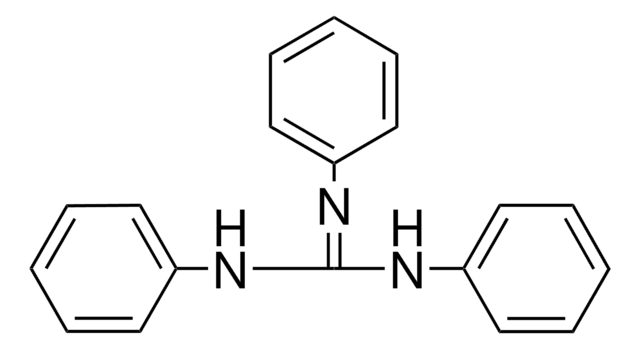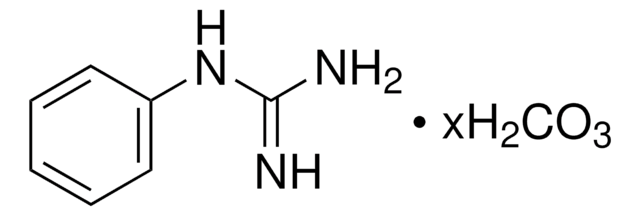All Photos(1)
About This Item
Empirical Formula (Hill Notation):
C8H9N5
CAS Number:
Molecular Weight:
175.19
EC Number:
MDL number:
UNSPSC Code:
12352100
PubChem Substance ID:
NACRES:
NA.22
Recommended Products
Quality Level
Assay
95%
mp
242-244 °C (dec.) (lit.)
SMILES string
NC(=N)Nc1nc2ccccc2[nH]1
InChI
1S/C8H9N5/c9-7(10)13-8-11-5-3-1-2-4-6(5)12-8/h1-4H,(H5,9,10,11,12,13)
InChI key
JJWCTKUQWXYIIU-UHFFFAOYSA-N
Storage Class Code
11 - Combustible Solids
WGK
WGK 3
Flash Point(F)
Not applicable
Flash Point(C)
Not applicable
Personal Protective Equipment
dust mask type N95 (US), Eyeshields, Gloves
Choose from one of the most recent versions:
Already Own This Product?
Find documentation for the products that you have recently purchased in the Document Library.
M Fronius et al.
The Journal of membrane biology, 195(1), 43-51 (2003-09-23)
In the present study we investigated the effect of extracellular gadolinium on amiloride-sensitive Na(+) current across Xenopus alveolar epithelium by Ussing chamber experiments and studied its direct effect on epithelial Na(+) channels with the patch-clamp method. As observed in various
A Pinelli et al.
Arzneimittel-Forschung, 34(8), 890-894 (1984-01-01)
In this study 2-guanidinebenzimidazole (GBI) and 1-phenylbiguanide (PBG) appear to be capable of decreasing gastric acid secretion, while the compounds dimethylbiguanide and cyanoguanidine do not. Thus, the antisecretory effect is present when the biguanide groups are associated with lipophilic molecules.
K Eskesen et al.
Acta physiologica Scandinavica, 136(4), 547-550 (1989-08-01)
Serosal amiloride inhibits Na+, K+ and Cl- efflux and reduces short-circuit current and transepithelial conductance in noradrenaline-stimulated frog skin in which the sodium channels in the apical membrane are blocked by amiloride. BIG (benzimidazoleguanidine) inhibits Na+ and K+ efflux and
Voltage-gated proton channels from fungi highlight role of peripheral regions in channel activation.
Chang Zhao et al.
Communications biology, 4(1), 261-261 (2021-02-28)
Here, we report the identification and characterization of the first proton channels from fungi. The fungal proteins are related to animal voltage-gated Hv channels and are conserved in both higher and lower fungi. Channels from Basidiomycota and Ascomycota appear to
P Komwatana et al.
The Journal of membrane biology, 162(3), 225-232 (1998-05-16)
We have previously shown that epithelial Na+ channels in mouse mandibular gland duct cells are controlled by cytosolic Na+ and Cl-, acting, respectively, via Go and Gi proteins. Since we found no evidence for control of epithelial Na+ channels by
Our team of scientists has experience in all areas of research including Life Science, Material Science, Chemical Synthesis, Chromatography, Analytical and many others.
Contact Technical Service






